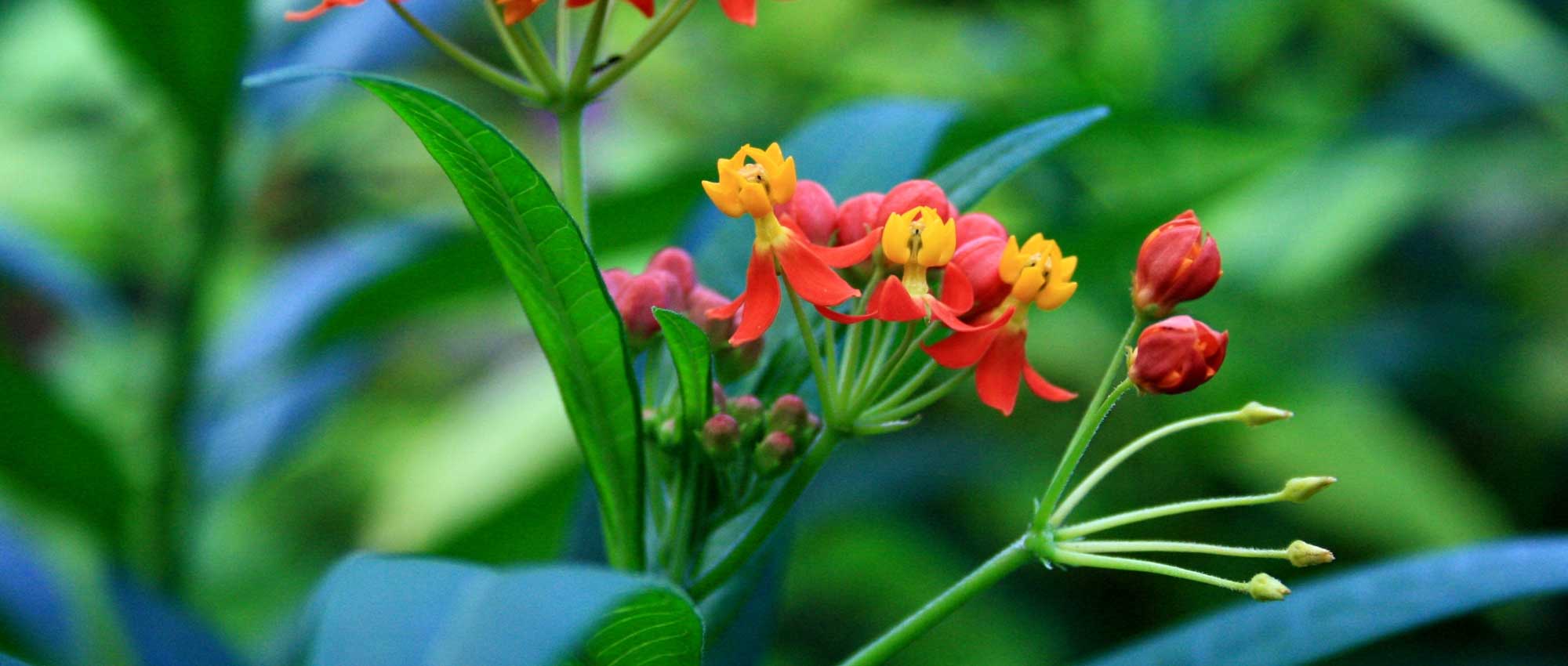
Asclepias: sowing, planting and care
Contents
Asclepiads in a nutshell
- Milkweeds are appreciated for summer flowering in umbels, with orange, pink or white colours.
- Asclepias tuberosa and Asclepias curassavica add a very exotic touch to the garden
- Other species with softer shades are perfect for naturalistic gardens and mixed borders
- Milkweeds need warmth and full-sun exposure
- They are easy to grow, require little maintenance and are rarely affected by diseases or pests!
A word from our expert
Milkweeds are perennial plants that offer a generous summer flowering. They are prized for their small star-shaped flowers, grouped in umbels, in shades of pink, mauve, white or orange. Discover the superb, very delicate pale-pink flowerings of Asclepias syriaca and Asclepias incarnata, as well as the bright orange flowering of Asclepias tuberosa. Asclepias syriaca, also called “Parrot Tree” or “Parrot-herb”, also has the advantage of producing decorative and unusual fruits resembling parakeets! Milkweeds’ foliage, by contrast, is fairly ordinary, green and elongated.
Milkweed is a full-sun plant that needs warmth and plenty of light. It is easy to grow and requires little maintenance. Asclepias syriaca and tuberosa tolerate drought fairly well, but Asclepias incarnata prefers moist, cool soils. Milkweeds are not much affected by pests or diseases. Depending on species and flowering colour, they will fit into naturalistic or wild gardens, or into exotic borders.
Description and botany
Botanical data
- Latin name Asclepias sp.
- Family Apocynaceae
- Common name milkweed, butterfly weed, cotton grass,
- Flowering depending on variety, between June and September
- Height 80 cm to 2 m
- Exposure full sun
- Soil type ordinary, free-draining, light
- Hardiness very variable (between -15°C and 0°C)
Asclepias are perennial plants, herbaceous or shrubby, comprising more than 200 species. They are mainly found in North and South America, and in Africa. One species, Asclepias syriaca, native to North America, has become naturalised in several regions of France. In the wild, Asclepias syriaca and tuberosa grow mainly in open habitats, on dry, poor soils, in meadows, by roadsides, on fallow land, wasteland, etc. Asclepias incarnata, by contrast, is found on moist soils, in marshes or at the edge of watercourses…
Milkweeds used to belong to their own family, the Asclepiadaceae, but they are now included in the Apocynaceae. This large family (more than 5,000 species) includes several ornamental plants, such as oleander, periwinkle and star jasmine (Trachelospermum jasminoides). Many species in this group originate from tropical or subtropical regions.
The genus was named by Linnaeus after Asclepios, the Greek god of medicine. In English, milkweeds are called “milkweed” (literally “milky herb”, probably referring to the white latex contained in their tissues).
The name Asclepias syriaca is synonymous with Asclepias cornuti. It is surprising that it was called “syriaca”, meaning “from Syria”, while it is native to North America. This is probably a confusion with another species. This milkweed also has several vernacular names: it is called “parrot-tree” because its fruits resemble the shape of those birds, and “cottonweed” in reference to its seeds bearing a large silky egret. It is also known as “gendarme plant”.
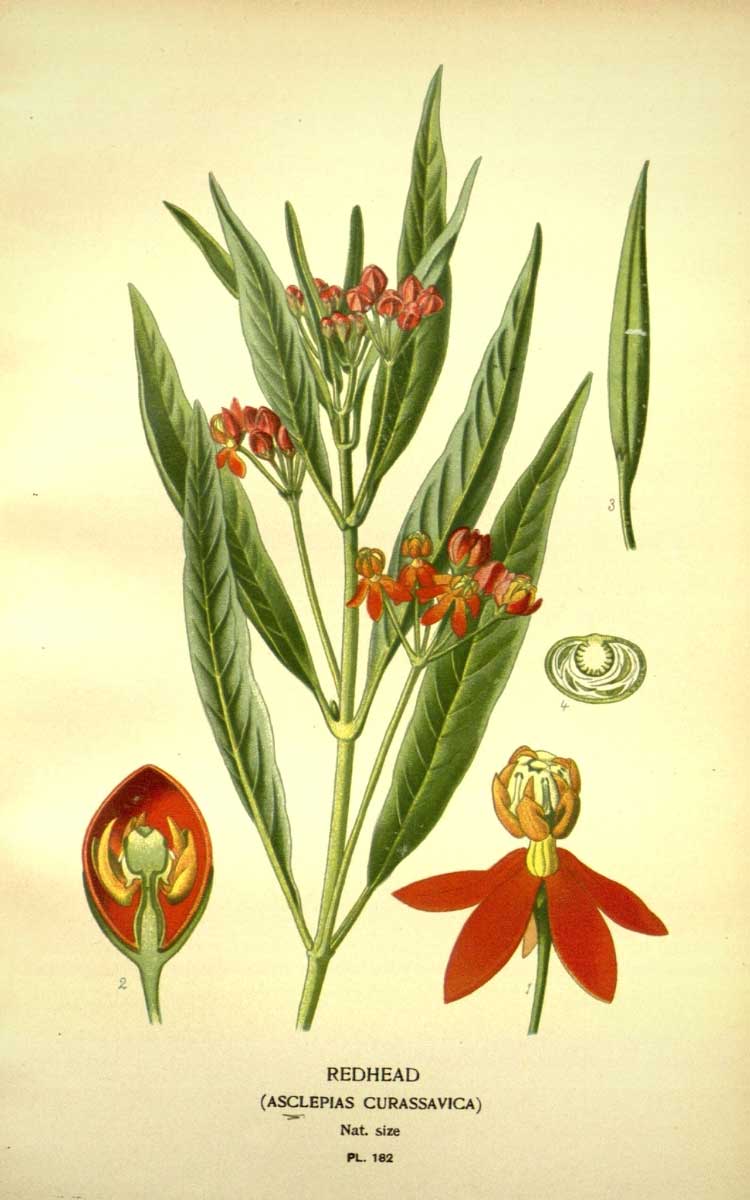
Asclepias curassavica: botanical illustration
Despite its name, gentian asclepiadea (Gentiana asclepiadea) has no relation to the milkweeds; it was named so because its leaves resemble those of milkweed.
Milkweeds are vigorous, fast-growing plants. They form fairly dense clumps of long erect stems topped with flowers. These are large perennials, reaching between 80 cm and 2 m in height. Asclepias tuberosa is somewhat shorter, at 50 cm to 1 m. Asclepias syriaca tends to spread widely and can form large colonies. It produces underground suckers and can become invasive.
Like many Apocynaceae, milkweeds contain a whitish latex in their tissues (toxic to most animals), visible when a stem or leaf is broken.
Milkweeds flower in summer, between June and September depending on species. Their flowers are small but grouped into umbels measuring 10–25 cm in diameter. Each inflorescence comprises a large number of star-shaped flowers.
These can take soft hues: pale pink (Asclepias incarnata), mauve, white (Asclepias ‘Ice Ballet’)… or, conversely, vivid orange (as in Asclepias tuberosa), yellow or red. The visual effect is completely different: the former integrate well into naturalistic borders or romantic cottage gardens… while the latter suit exotic beds or very colourful mixed borders. Asclepias curassavica offers a beautiful gradation of colours between red, orange and yellow. There are also varieties with yellow flowers, such as Asclepias ‘Hello Yellow’.
Milkweed flowers are very specialised, arranged in a rather unique way. They consist of five petals reflexed backwards, and five sepals. Each flower bears a corona made up of five upright, concave membranes that might be mistaken for petals, each carrying a curved horn. At the centre is a gynostemium: a column formed by fused stamens and pistils.
Pollen is not in individual grains as in most plants, but gathered into masses called pollinia. When insects seek nectar, they slip a leg or rostrum into one of the five slits formed by adjacent anthers. The pollinia then attach mechanically to the insect. They can only be carried off by the strongest insects; weaker ones risk becoming trapped in the stigma slits, turning the flower into a deadly trap.
Generally, milkweed flowers are scented (notably Asclepias syriaca and Asclepias incarnata), emitting a pleasant vanilla fragrance.
Milkweeds are excellent melliferous plants; they produce nectar much appreciated by insects (bees, wasps, butterflies…). Milkweeds play a very important ecological role, feeding many insects… And in North America they are the exclusive food source for the larvae of the magnificent Monarch butterfly.

Flowering of Asclepias curassavica (photo Derek Ramsey), Asclepias tuberosa, and Asclepias sullivantii (photo Frank Mayfield)
Milkweed leaves are simple, undivided, with an ordinary shape, lanceolate or ovate. They measure 7–25 cm in length and are finer depending on species. Asclepias fascicularis, for example, has a very narrow lamina. Many species have opposite leaves (A. curassavica, A. syriaca…), but they can also be alternate or spiralled (A. tuberosa). Leaves are green and marked by a prominent white vein down the centre.
Asclepias syriaca has running, thick rhizomes, producing suckers. These are horizontal underground stems that generate new shoots, which explains how this species can rapidly form large colonies.
As its name suggests, Asclepias tuberosa has tuberous roots, making it more drought-resistant. Asclepias incarnata, meanwhile, has thick white roots specially adapted to wet soils low in oxygen.
After flowering, milkweeds produce fairly large fruits, measuring 6–15 cm in length. They can be elongated, oblong or more globose, usually tapered to a pointed tip. They are not smooth but covered with roughness or soft thorns. The fruits are particularly long and slender in Asclepias tuberosa. Those of Asclepias syriaca are much appreciated because they resemble little parrots, which can be hung, for example, on the rim of a glass. They are very decorative.
When ripe, the fruits split open and release small flat brown seeds. These seeds bear large silky white egrets, which allow them to be carried by the wind! It is therefore the wind that disperses milkweed seeds. The fibres can even be used to produce a very high-quality, hydrophobic, strong insulating fibre.

Fruits of Asclepias syriaca, whole then releasing seeds with silky egrets
Read also
14 unusual fruitsMain milkweed varieties
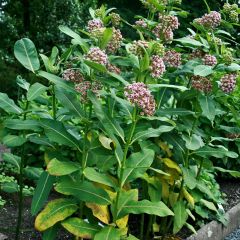
Asclepias syriaca ou cornuti - Herbe aux perruches
- Flowering time July to September
- Height at maturity 1,20 m
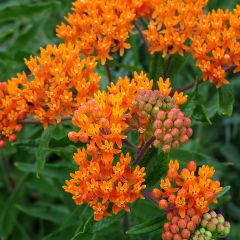
Asclepias tuberosa - Milkweed
- Flowering time August to October
- Height at maturity 60 cm
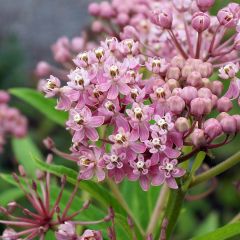
Asclepias incarnata - Milkweed
- Flowering time July to September
- Height at maturity 1,20 m
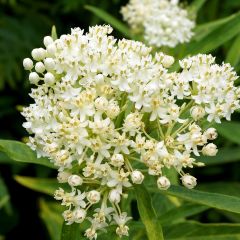
Asclepias incarnata Ice Ballet - Milkweed
- Flowering time July to September
- Height at maturity 1,20 m
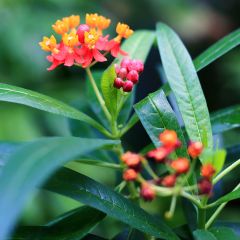
Asclepias curassavica - Milkweed
- Flowering time July to November
- Height at maturity 90 cm
Discover other Asclepias
View all →Available in 3 sizes
Available in 1 sizes
Available in 1 sizes
Available in 1 sizes
Available in 1 sizes
Available in 1 sizes
Available in 1 sizes
Available in 1 sizes
Available in 1 sizes
Available in 1 sizes
Planting
Where to plant?
Milkweeds are plants that like heat and full sun, essential for ensuring generous flowering. Choose a well-exposed spot with excellent light. If you live in southern France, you can place them in partial shade.
They need well-drained soil, where water does not stagnate but soaks away quickly. Asclepias syriaca and Asclepias tuberosa prefer relatively dry, poor soils. Feel free to add some coarse sand before planting. Conversely, some species such as Asclepias incarnata and Asclepias speciosa enjoy moist soil. You can plant them by a pond. Overall, milkweeds are not very sensitive to pH. However, it is best to site them somewhere sheltered from strong winds.
You can also grow milkweeds in pots. This both allows you to bring the more tender ones under cover and to contain the spread of a species such as Asclepias syriaca.
Be careful with Asclepias syriaca, which has already naturalised in several French regions. You can plant it in a pot, or install a rootstock barrier to limit its spread.
It is best to choose the location carefully, because once established milkweeds do not like to be moved. Their root system, which penetrates deeply into the soil, could be damaged by transplanting.
When to plant?
Plant milkweeds preferably in spring, from May onwards, once frosts are no longer a concern.
How to plant?
If planting several plants, keep 40 to 60 cm between them, depending on variety.
- Place the plant in a tub of water to thoroughly moisten the rootball.
- Dig a planting hole at least twice the size of the rootball. Add drainage material if necessary (except for Asclepias incarnata) if your soil tends to retain water. If you grow Asclepias syriaca, you can install a rootstock barrier to prevent it spreading too much.
- Set the rootball in the planting hole.
- Backfill with soil.
- Water thoroughly.
Continue to water regularly until the plant establishes and resumes growth.
It is also possible to plant milkweeds in a pot or planter. For this, choose a large, deep container (milkweeds’ root system is well developed). Place a layer of drainage material, then a light potting compost, and plant. Backfill around and water.

Asclepias tuberosa
Care
Milkweeds are easy plants that thrive (and sometimes spread) readily. Their care is limited to fairly basic tasks.
Once established, Asclepias syriaca and tuberosa tolerate drought quite well. You can nevertheless water them occasionally in summer to support flowering. Asclepias incarnata needs slightly cooler soil than other species, and will therefore require more regular watering.
For Asclepias syriaca, you can leave faded flowerheads in place to allow the plant to produce unusual, decorative fruits shaped like parakeets; but harvest these fruits before their full ripeness to prevent them from dispersing seed – this species can become somewhat invasive. For other milkweeds, you can either leave faded flowerheads to obtain fruits and seeds, or cut them (which relieves the plant and can prolong flowering).
We recommend pruning milkweeds in autumn, around November, cutting back foliage close to soil.
Milkweeds, if exposed to winds, may need staking to prevent their stems from flopping over.
If you grow less hardy species (like Asclepias curassavica), consider protecting them in winter by bringing them under cover. If your milkweeds remain outdoors, even if relatively hardy you can lay a thick mulch around the stump to protect it.
Milkweed is sometimes attacked by whiteflies, commonly called “mouches blanches”. These small insects are noticeable when they fly up as leaves are disturbed. They weaken plant by feeding on sap. You can treat infestations using black soap diluted in water. Overall, Asclepias have few enemies (at least in France, since in North America their leaves are eaten by monarch caterpillars), because they are toxic to most animals!
Multiplication
To propagate milkweeds, best technique seems to be sowing. Also possible to divide clumps, take stem cuttings, or, for Asclepias syriaca, propagate by rootstock cuttings.
Sowing
You can sow milkweeds under cover in late winter (February–March) or in early spring. Best to place seeds in fridge for 3–6 weeks before sowing (cold stratification).
- Prepare a pot by filling with light potting compost (use seed compost or a mix of compost and sand). Firm and level surface.
- Place seeds on surface.
- Cover with thin layer of sieved compost.
- Water with fine spray.
- Place pot under cover in bright spot out of direct sunlight.
Remember to water regularly after sowing and during first year of cultivation. Pot on young seedlings as soon as large enough to handle.
Dividing clumps
You can divide milkweeds in late autumn once plant has entered dormancy. Start by carefully digging up a clump of milkweeds, then split into several pieces using a spade. Replant each in a new position, then water generously.
Asclepias companion planting in the garden
Because their flowers are appreciated by pollinating insects, you can include asclepias in a garden favourable to biodiversity, alongside other melliferous plants. Choose, for example, scabious, salvias, phacelia, Verbena bonariensis, nepeta, lavender… Create a very natural, wild-looking border, favouring flowers rich in nectar that are visited by insects for foraging. In this type of garden, it is useful to stagger flowering over a long period so insects can feed throughout the year.
Species with soft pink flowers, such as Asclepias syriaca, fit very well into naturalistic gardens. It offers gentle flowering and has a wild habit that blends easily into a landscape. Plant it with plants of a free, airy habit, such as Verbena bonariensis, Gaura lindheimeri, Veronicastrum, or Epilobium… In this type of garden, you can also choose Asclepias incarnata, especially if soil is cool or moist.
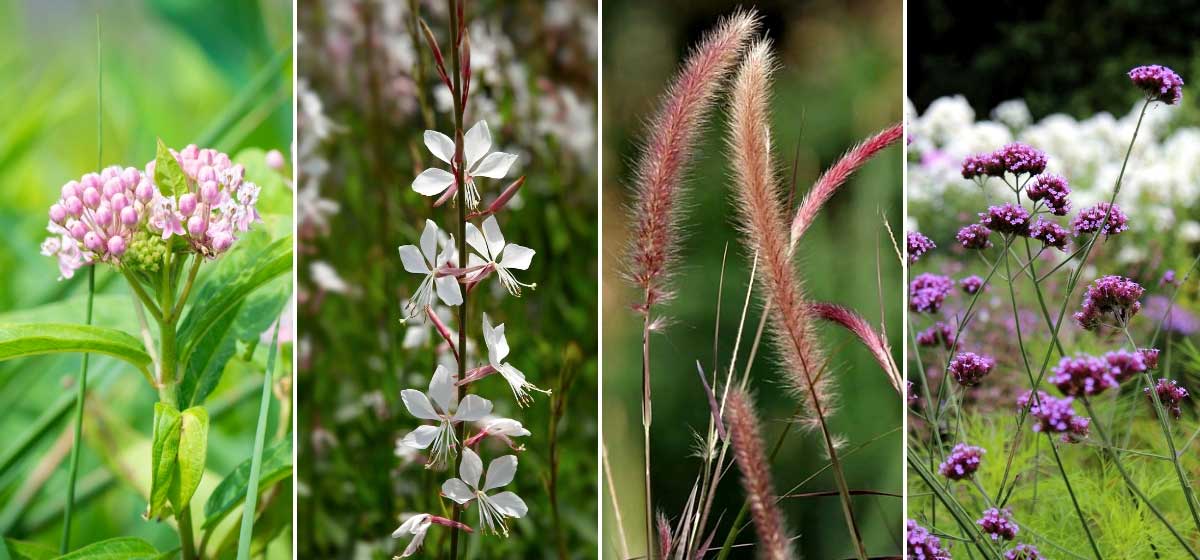
Asclepias with pink or mauve tints can be included in naturalistic borders. Asclepias incarnata (photo Andrew C.), Gaura lindheimeri ‘Whirling Butterflies’, Pennisetum setaceum and Verbena bonariensis (photo Acabashi)
Conversely, asclepias with orange flowers, such as Asclepias tuberosa or Asclepias curassavica, will find their place in an exotic-style garden. To accompany them, favour flowering in vivid, dynamic and warm hues. You can choose kniphofias, daylilies, crocosmias, or eucomis. Add some decorative foliage, such as Phormium, Imperata cylindrica ‘Red Baron’, or castor bean plants.
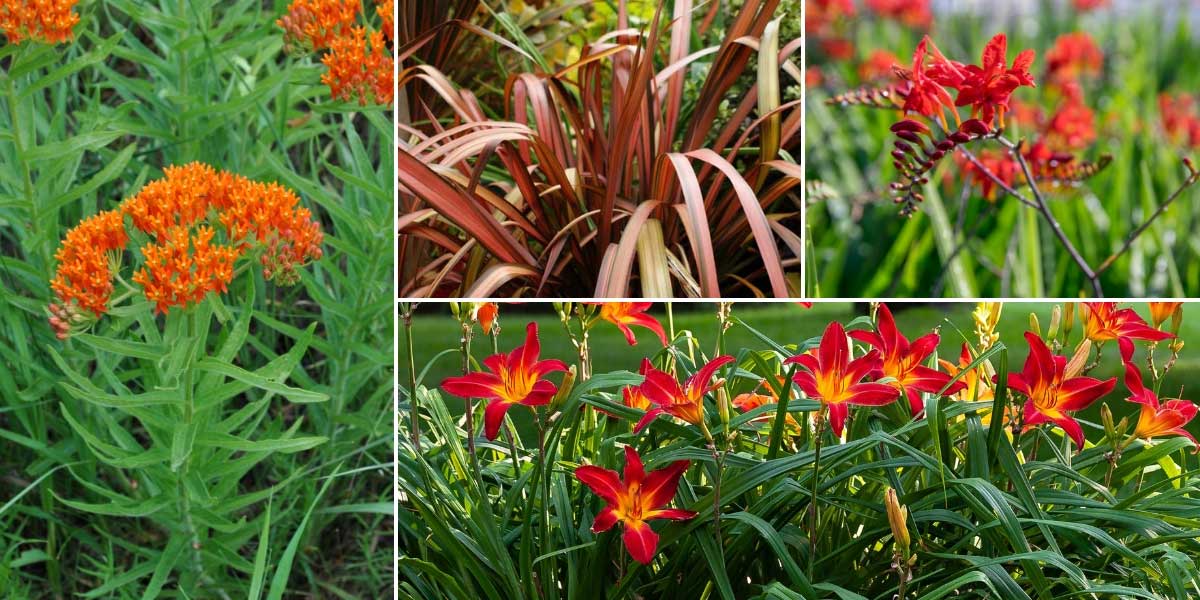
Asclepias with bright orange, yellow or red flowers are better suited to exotic-style gardens. Asclepias tuberosa (photo Aaron Carlson), Phormium ‘Pink Panther’, Crocosmia and daylilies
Plant the edges of a pond or water feature with Asclepias incarnata. You can plant it with meadowsweet, loosestrife, epilobium, ligularias, Cirsium rivulare, Eupatorium… This asclepias has the advantage of offering very natural-looking flowering and foliage, which allows creation of a rather wild area made up of vegetation that appears spontaneous, as you would find naturally at the edge of a watercourse.
→ Discover other ideas to combine Asclepias in our article !
Did you know?
- Milkweeds and monarchs
In North America, the magnificent monarch butterfly, which undertakes large migrations moving by the millions, depends on milkweeds for its life cycle. Indeed, its larvae feed almost exclusively on milkweed leaves. And although the plant is toxic to most animals, monarchs are able to consume the leaves and assimilate the toxic substances, which in turn makes them indigestible to their predators! The butterfly has benefited from this same toxicity that protects the plant from herbivores.
- Uses
Silky egrets attached to the seeds of Asclepias syriaca can be used to obtain a fibre of excellent quality: hydrophobic, strong, resistant and insulating. It is cultivated in Canada for these qualities, which is why this plant is sometimes called ‘Quebec silk’. It can be used, for example, to make warm clothing or to stuff pillows. It is also notable for its ability to absorb hydrocarbons, but not water, and can therefore be used to remediate after accidental oil spills.
Useful resources
- Discover our range of Asclepias
- Use Asclepias to create a naturalistic garden
- To combine Asclepias tuberosa and curassavica – Exotic ambience
- Our article – How to create a beautiful perennial border?
- Our article: Combining Asclepias
- Learn more about perennials with ornamental fruit
Frequently asked questions
-
Small white insects fly off when I touch the plant. Why?
They are whiteflies, tiny insects that settle under leaves and extract sap, weakening and slowing growth of plants. You can treat by spraying a black soap solution, or by placing yellow sticky traps to catch adults that land on them.
-
Can milkweed become invasive in my garden?
While most species remain in place, Asclepias syriaca tends to spread over time and can become somewhat invasive in gardens. To avoid this, simply grow it in a pot or install a rootstock barrier. You can also cut the fruits before they reach ripeness and release the seeds.
- Subscribe!
- Contents
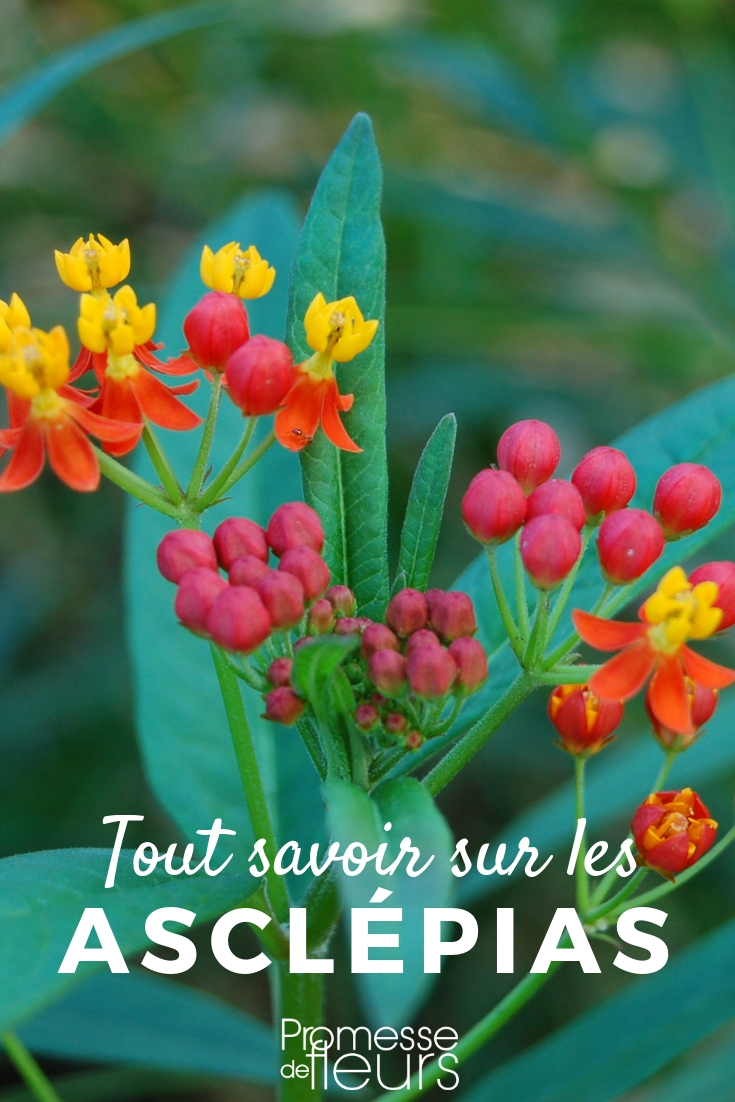

































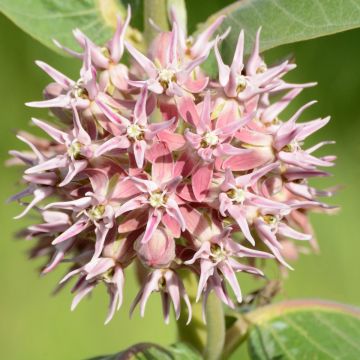
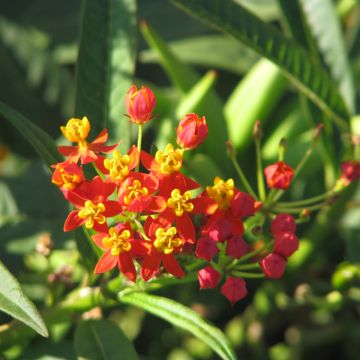
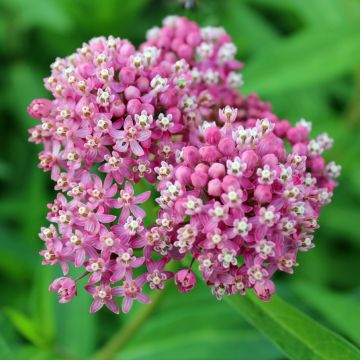
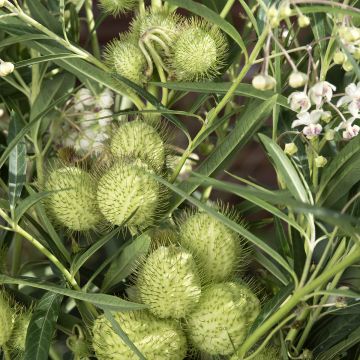
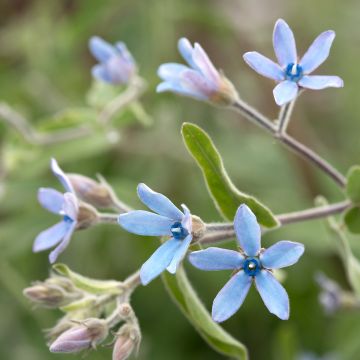
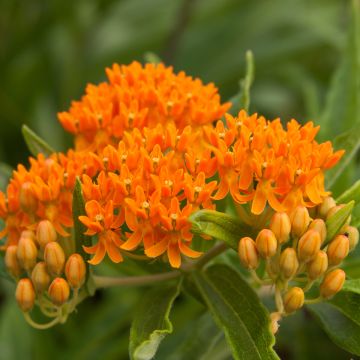
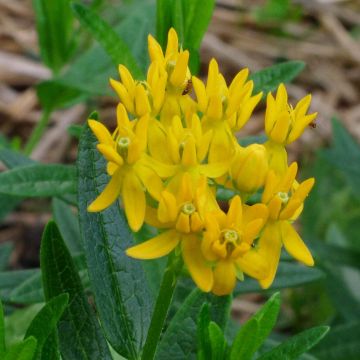

Comments